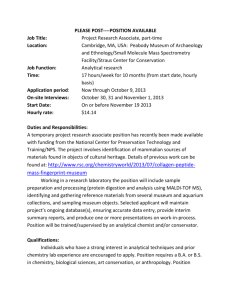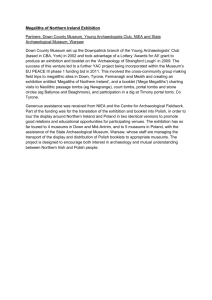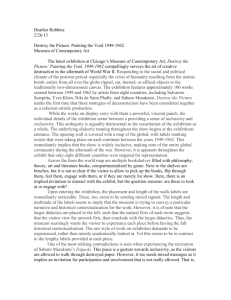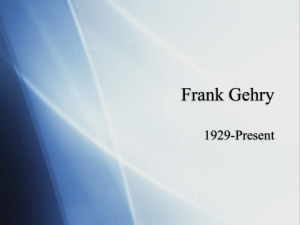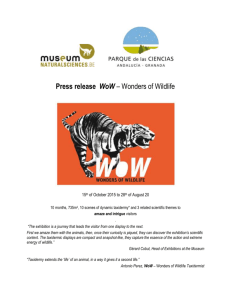Fall, 2002 - Costume Society of America
advertisement
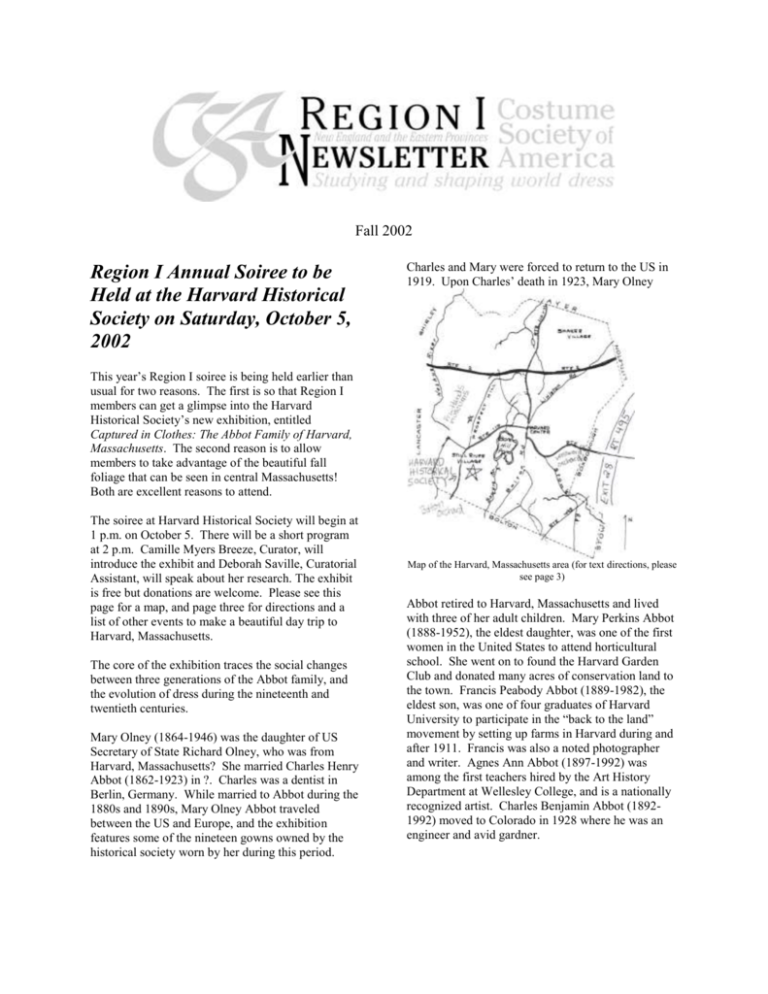
Fall 2002 Region I Annual Soiree to be Held at the Harvard Historical Society on Saturday, October 5, 2002 Charles and Mary were forced to return to the US in 1919. Upon Charles’ death in 1923, Mary Olney This year’s Region I soiree is being held earlier than usual for two reasons. The first is so that Region I members can get a glimpse into the Harvard Historical Society’s new exhibition, entitled Captured in Clothes: The Abbot Family of Harvard, Massachusetts. The second reason is to allow members to take advantage of the beautiful fall foliage that can be seen in central Massachusetts! Both are excellent reasons to attend. The soiree at Harvard Historical Society will begin at 1 p.m. on October 5. There will be a short program at 2 p.m. Camille Myers Breeze, Curator, will introduce the exhibit and Deborah Saville, Curatorial Assistant, will speak about her research. The exhibit is free but donations are welcome. Please see this page for a map, and page three for directions and a list of other events to make a beautiful day trip to Harvard, Massachusetts. The core of the exhibition traces the social changes between three generations of the Abbot family, and the evolution of dress during the nineteenth and twentieth centuries. Mary Olney (1864-1946) was the daughter of US Secretary of State Richard Olney, who was from Harvard, Massachusetts? She married Charles Henry Abbot (1862-1923) in ?. Charles was a dentist in Berlin, Germany. While married to Abbot during the 1880s and 1890s, Mary Olney Abbot traveled between the US and Europe, and the exhibition features some of the nineteen gowns owned by the historical society worn by her during this period. Map of the Harvard, Massachusetts area (for text directions, please see page 3) Abbot retired to Harvard, Massachusetts and lived with three of her adult children. Mary Perkins Abbot (1888-1952), the eldest daughter, was one of the first women in the United States to attend horticultural school. She went on to found the Harvard Garden Club and donated many acres of conservation land to the town. Francis Peabody Abbot (1889-1982), the eldest son, was one of four graduates of Harvard University to participate in the “back to the land” movement by setting up farms in Harvard during and after 1911. Francis was also a noted photographer and writer. Agnes Ann Abbot (1897-1992) was among the first teachers hired by the Art History Department at Wellesley College, and is a nationally recognized artist. Charles Benjamin Abbot (18921992) moved to Colorado in 1928 where he was an engineer and avid gardner. (story continued on page 3, including directions to Harvard Historical Society and things to do in the area that weekend!) Costume Society of America Region I Board Members President Jeffrey Butterworth Vice President Susan Jerome Secretary Jacqueline Field Carrie Alyea Joanna Cadorette Rebecca Fifield Karen Herbaugh David Lazaro Maryann Sadagopan Past President: Claudia Iannuccilli Appointed Officers & Committee Chairs Treasurer Pat Baker Scholarship Chair Carrie Alyea Membership Chair Karen Herbaugh Newsletter Editor David Lazaro Fall 2002 Program Chair Jackie Field Publication Sales Joan Walther The Region I Newsletter is published three times a year. The deadline for the next issue is December 15, 2002. Please send exhibit listings, new book notices, professional news, etc., to: David E. Lazaro 234 Florence Road Florence, MA 01062 lazaro@historic-deerfield.org The newsletter editor is always seeking volunteers to help with the Region I newsletter. If interested, please contact me at lazaro@historic-deerfield.org For this issue, I would like to thank Rebecca Faria for her help. President’s Message Dear Fellow CSA Region I Members: As I write this, it is hot, very hot, steamy hot. The record for number of 90 degree plus days have been broken and water restrictions are slowly seeping their way into the news. Global warming? It is difficult to reconcile geo-politics with the plants that are dying in my garden. War with Iraq? The Middle East in seeming escalating turmoil, flooding in Eastern Europe; cultures in peril and subsequently the artifacts of those cultures are challenged as well. I once had a French hand-sewing teacher that thought that if all of the world's leaders sat on a porch and roll, whipped and layed a couple of seams for an hour or two there just wouldn't be any problems. It may be time for school and my work-life to resume. The Region I Board of Directors met in June and I was very impressed with the excitement and dedication of the Directors. We are very lucky to have such a team. As an example, I will single-out for much deserved praise our current Treasurer, Pat Baker. Pat is an appointed (non-voting) participant in the Board because after her last term ended, having learned the intricacies of the budget and all monetary aspects of Region I, she willingly chose to stay on. She is also the Registrar Extraordinaire of most of our Regional (as well as the occasional National) Symposia. I do not know what we would do without her, so thank you Pat. I could write similar praise for all of the Directors, because they are just those kind of people. Jacqueline Field is definitely one of those kind of people and is graciously chairing the Fall Symposium SHOW & TELL AND MYSTERY OBJECTS, November 16, 2002 at the American Textile History Museum in Lowell, MA. It will be extremely interesting to view both extraordinary artifacts and those with uncertain pasts or functions. I am always amazed at the incredible diversity of extant costume and textile objects and relish the fact that "there is always something new under the sun." Writing of extraordinary artifacts...I suppose that there comes a time in every organization when archives become important. That time for CSA is now. There has been pressure handed down from National to get the Regional archives in order and we (the Board, past and present, and some other patient individuals) have been trying to sort out our scattered files and closets to secure an accurate representation of Region I activitites and pursuits that will be appropriately stored in one place. (continued on page 3) President’s message continued… The process is well underway and elsewhere in this Newsletter current and past Vice Presidents and Historians, Susan Jerome and Adrienne Saint Pierre have created a list of things that are missing. If you have any of the missing pieces, please contact Susan. The best part of doing this now is that once it is done, we won't have to do it again, as long as we are regular in maintaining updates. I have been able to fashion a list of all Region I Symposia and Meetings from the first in September of 1984 to the last in Hartford. Archives can be useful (again, thanks Pat!) Did I write that volunteering in any, and or all, of these areas would be a wonderful thing? (I thought of writing "good thing" but Martha Stuart and corporate America have entered the realm of imponderable along with war and global warming.) Have a terrific Fall and I hope to see you in Lowell. Jeffrey A. Butterworth Historical Society on Prospect Hill Road, is open from 10 a.m. to 5 p.m. daily until the end of October. The tea room at Fruitlands is an excellent place to eat lunch. Sandwiches and soup are also available at Bolton Orchards, at the intersection of Rt. 110 and Rt. 117 in Bolton, and at Westward Orchards on Rt. 111, one mile west of Rt. 495. The Harvard area has many beautiful orchards for apple picking. Directions to the Harvard Historical Society From Rt. 495 S Take Rt. 495 S to exit 28. Turn W onto Rt. 111 toward Harvard. Stay on Rt. 111 until you come to a blinking light at the town common. Turn left onto Rt. 110/Still River Road. Stay on Still River Road until you pass the Still River post office. The Harvard Historical Society is 1/10 of a mile past the post office on the left. From Rt. 495 N Take Rt. 495 N to exit 27. Turn W onto Rt. 117 toward Bolton. Stay on Rt. 117 to the intersection of Rt. 110. Turn right onto Rt. 110 N towards Harvard. The Harvard Historical Society is 1/10 of a mile past the St. Benedict’s Center on the right. >>>>><<<<< Region I Soiree information continued… The first room of the exhibit deals with the 19th century. Along with Mary Olney Abbot’s gowns are featured other family memorabilia and period objects. The shift in costume from the 1870s through 1900 is illustrated using costume from the Harvard Historical Society’s collection. The second room of the exhibit highlights the 20th century and the lives of Mary Olney Abbot’s children. All four children were born in Germany and had very a formal, urban childhood; however as adults each chose rural lifestyles that centered on nature. The reaction against industrialization and towards a life lived on, and in harmony with, the land is reflective of greater social movements on a local, national, and international level. Captured in Clothes: The Abbot Family of Harvard, Massachusetts provides a unique illustration of the shift in lifestyle, philosophy, and clothing between two generations of a extraordinary Harvard family. Research assistance for this exhibit was provided by the Bay State Historical League and the Massachusetts Foundation for the Humanities. Harvard, Massachusetts provides an ideal setting for a day trip on October 5. The Fruitlands Museum, located approximately one mile from The Harvard From Rt. 2 Take Rt. 2 to exit 38A. Turn right onto Rt. 111. Turn right onto the first road you come to, Old Shirley Road (no street sign). Go straight through the next intersection. Old Shirley Road becomes Prospect Hill Road. At the end of Prospect Hill Road take a right onto Still River Road. The Harvard Historical Society is 1/10 of a mile past the post office on the left. For questions, please contact Camille Myers Breeze at camillebreeze@hotmail.com or 978.851.0110. Hope to see you there! >>>>><<<<< Call for Nominations It’s never too early to start thinking about good candidates for next year’s class of Region I Board members. The election takes place during early Spring and results will be announced during our Spring Annual Meeting on April 5, 2003 at Old Sturbridge Village in Sturbridge, MA. The deadline for nominations is February 1, 2003. Serving on Region I’s Board is a great way to get better involved with CSA. Please submit the names of potential nominees (including your own if you desire) to Becky Fifield, 86 Creeley Road, Belmont, MA 02478 News from the Education Committee Karen Kaplan was this year's recipient of Region 1's scholarship registration for CSA's National Symposium held this past June in Chicago. A graduate student at the University of Rhode Island, Karen Kaplan is finishing her Master's Degree in Textiles, Fashion Merchandising and Design with an emphasis on Historic Dress and Textiles and is planning to defend her thesis this summer. She has been a graduate teaching assistant for Dr. Linda Welters for the 2001-2002 school year, working with undergraduate students and teaching classes in Historic Costume. As a result of this positive experience, Karen plans to pursue a career as an educator in the field of Costume and Textiles, preferably teaching in a community college setting. She has worked as a guide at Slater Mill Historic Site in Pawtucket, RI and is currently completing an internship at Slater Mill as assistant to the curator, Karin Conopask. Karen has a background that includes 20 years specializing in outpatient education in nutrition and dietetics, and experience teaching dance. She looks forward to teaching in the field of clothing and textiles, an area of study in which she has found much passion and satisfaction. In Her Own Words… As the fortunate and grateful recipient of the Region I scholarship, I attended the CSA National Symposium in Chicago, “The Future of Dress: Education and Advocacy.” The juried papers were outstanding and included a number of interesting topics, such as “The Speaking Shoe” presented by Millia Davenport Award winner, Nancy Rexford; “Moving Fashion Forward” presented by Susan North of the Victoria & Albert Museum; “Cutltural Geography and Ethnic Dress” presented by Linda Welters, professor at The University of RI; and “Ideals of Futuristic Dress in Art and Fashion” presented by Patricia A. Cunningham, professor at The Ohio State University. In addition to the paper presentations, some CSA members, myself included, were treated to a behind the scenes tour of the Chicago Historical Society, presented by Loreen Finkelstein and Joel Thompson, Chair and Assistant Curator, respectively. That same evening, CSA members attended a reception and fashion walk at Columbia College Chicago, where we were able to view costumes and artifacts from the Fashion Columbia Study Collection and art work by CSA members. One of my favorite activities, however, was the lunch and student fashion show held on Friday at Columbia College Chicago, which was exciting and highly entertaining. Of course, one cannot fail to mention the Marketplace, Silent Auction, and Poster Session, but an interesting addition to the symposium this year was the Vintage Clothing Evaluation Day held on Saturday. CSA members brought in clothing, quilts, and jewelry to be evaluated by experts on 18th, 19th, and 20th century periods. Overall, the CSA National Symposium was an excellent mix of scholarship, networking, and entertainment. How YOU can help… Fund raising continues so that Region 1 may offer future scholarships to student members. On the registration form for the Fall 2002 Regional Symposium, you will have an opportunity to help the scholarship fund. Simply check the appropriate box and include your contribution with your registration fee. In this way, you help the future of our organization by helping students. Please consider giving - if more funds are raised Region 1 will be able to help more students attend future meetings. Thank you. >>>>><<<<< New Exhibition at the McCord Museum Looks at Men’s Fashion The McCord Museum in Montreal is featuring an exhibition entitled Clothes Make the MAN. The exhibition focuses on two subjects commonly thought to be mutually exclusive: men and fashion. Women’s clothing tends to dominate museum collections, and until recently, there have been very few exhibitions devoted solely to the subject of men’s fashion. Besides tracing the evolution of garments and styles, Clothes Make the MAN explores the diverse factors that have influenced men’s clothing choices across three centuries. The exhibition attempts to debunk the myth that practicality is the main influence on men’s clothing and shows how even small changes reflect broad shifts in cultural ideals. Featured garments in the exhibition include a lavishly embroidered 18th-century silk waistcoat, an austere, mid-19th-century wool frock coat and a faultlessly tailored 20th-century Savile Row suit. The exhibition was developed by guest curator Gail Cariou, along with the McCord’s Curator of Costume and Textiles, Cynthia Cooper, and Curatorial Assistant at the McCord, Eileen Stack. For more information, please call (514) 398-7100, ext. 305. >>>>><<<<< American Textile History Museum to open exhibition on Dolls Styles of the Times is September Theme at Old Sturbridge Village Entitled Reflections: Fashion, Dolls, and the Art of Growing Up, the exhibition will run from November 9, 2002 through March 23, 2003. From the early 19th century Baby to Barbie, the new exhibition at the American Textile History Museum is a nostalgic trip through childhood and a look at how girls perceptions of themselves and the fashions they emulate have changed. It will also be a chance to glimpse the fantasies of earlier generations of children and to compare it to our own notions of childhood, girlhood and womanhood today. Mother and daughter fashions from the 19th century will be shown within scenes of a typical household from that time, complete with little girls dolls and toys are a part of the exhibition. A series of fun and exciting costume filled vignettes ensue allowing the visitor to time travel from the 19th century and return to the present day. Running from November 9, 2002 through March, 23, 2003, this holiday treat will help visitors explore how generations of little girls lives have been shaped by and are reflected in some of their most dearly-loved playthings, their dolls. Highlights Include Functional Fashions on September 7, Household Must-Haves on September 14, An Early 19th-Century Agricultural Fair on September 21 and 22, and House Beautiful, Early New EnglandStyle on September 28 On Saturday, September 7, visitors will get a look at Functional Fashions. A special presentation in the Parsonage Barn entitled "Dressing Out" addresses a commonly asked question at the museum -- "What's under there?" -- as a married couple changes from their everyday clothes to their finest for a ball. At the Towne House, there will also be a special demonstration of hairstyling from a time when adding grease to the hair -- rather than washing it out -- achieved the desired look for a special evening out. Aimee E. Newell, Old Sturbridge Village's curator for textiles and fine arts, will give two special presentations on this day, one on jewelry worn (or not) by early New Englanders, the other entitled "Frocks, Cloaks, and Pumpkin Hoods: How to Dress Wisely (and Warmly) for an 1830s Winter." For more information, visit www.osv.org, or call 800-SEE-1830 (TTY 508-347-5383). “Dressing for the Ball” at Old Sturbridge Village Save the Date! An image from the ATHM exhibition Reflections: Fashion, Dolls, and the Art of Growing Up On Saturday, April 5, 2003, Region I will hold its Spring Symposium, Understructures: Shaping the Body, Fashioning the Person. See the call for papers in this newsletter for more details. >>>>><<<<< >>>>><<<<< NOVEMBER 16, 2002 FALL SYMPOSIUM MARK YOUR CALENDARS November 16 is the date of the Region I Fall symposium Show & Tell and "Mystery Objects at the American Textile History Museum, Lowell, Massachusetts. The program includes a "Date and Identify" panel. Have you ever wanted to ask an expert about your vintage articles? Present your items to the panel. Solve "mysteries," learn about your items, and how to care for them. There will also be opportunity for participants to share their vintage garments, accessories, shawls or quilts during a Breakout Session. This session is designed to provide an informal setting for everyone to show, look, talk, ask questions, discuss and exchange information with fellow conference goers. This is a chance for everyone to take part--come and participate. Everyone who brings something will be eligible for the prize drawings. 2003 Historic Fashions Calendar Offers Glimpses Into Many Region I Collections Undergarments have shaped both the history of fashion as well as perceptions of how we view the body. Whether hidden under layers of clothing or worn on the outside, undegarments are vital to fashion’s overall look. The Costume Society of America annual calendar for 2003 is a virtual “bookon-the-wall” for historic undergarments. Entitled Beneath Historic Fashions, the calendar documents amazing examples of undergarments, many of which are located in collections here in New England. January features nineteenth and early twentieth century corsets from Karen Augusta Antique Lace and Fashion. The month of March showcases late eighteenth and nineteenth century undergarments from the Henry Sheldon Museum of Vermont History. Items from the Fairfield Historical Society are featured in the month of June, as well as on the calendar cover, and include an 1897 wedding dress and corset. During the month of September , viewers are treated to glimpse into the University of Rhode Island Pattern Archive, with patterns of undergarments from the first half of the twentieth century. Beneath Historic Fashions will be available for sale at the Region I Symposium on November 16, 2002. They are also available now in many museum shops or, by calling Texas Tech University Press at (800) 832-4042. A portion of the calendar sales will benefit Costume Society of America’s programs and awards. >>>>><<<<< BROWSER’S CORNER Incidentals seen, heard, discussed, read or read about . . . miscellaneous books, TV, movies, etc. . . .by Jacqueline Field. Books Kimono: Fashioning Culture. Lisa Critchfield Derby. University of Washington Press. A reviewer notes the author "offers a tour of cultural collisions that have become part of the fabric not just of the kimono but of modern Japan." Consuming Subjects: Women, Shopping, and Business in the Eighteenth Century. Elizabeth Koweleski-Wallace. New York: Columbia University Press, 1997. Paperback. This interdisciplinary study is described by one reviewer as a "feminist literary critic's attempt to explain that [18th century] society's complex interplay of gender and economics in the language of fashion." Movies/Videos Goya in Bordeaux. A 2000 film by Spanish director Carlos Saura. The costumes provide an interesting view of Spanish late 18th century aristocratic dress. At points in the movie the camera deliberately focuses in and moves slowly over beautiful details giving time for the viewer to observe closely. Available in video. Exhibitions / Galleries: A selection of dancer Nureyev's costumes along with 60 black and white photographs, drawings, and paintings in the exhibition "Capturing Nureyev: James Wyeth paints the Dancer" will be at The Farnsworth Art Museum, Rockland Maine through January 5, 2003. BROWSERS CORNER welcomes contributions. Email your input to jrobert4@maine.rr.com >>>>><<<<< Fairfield Historical Society to Host Exhibition of John Burbridge’s Fashions In Miniature The Fairfield Historical Society will present John Burbidge's Fashion in Miniature: Les Petites Dames de Mode from September 7 through November 3, 2002. Fifty of the 29-inch high mannequins, exquisitely dressed in Victorian and Edwardian haute couture fashions, will be displayed. Representing costume from 1855 to 1914, the "Little Ladies" are presented in settings with furniture and accessories perfectly in scale. The Historical Society is located at 636 Old Post Road, Fairfield, CT 06824 (FYI, new zip code). The hours for this exhibit are Tuesday through Saturday from 10 a.m. to 4:30 p.m., Thursday evenings until 7:30 p.m., and on Sundays from 1 to 4:30 p.m. Closed Mondays except for Columbus Day. John Burbridge will be giving a lecture on Sunday, October 20 at 2p.m. Call 203/259-1598 for more information. Pictured below are just two of the miniatures; Stylish Street Toilette, left, and Casino Toilette, right. David E. Lazaro, Region I Editor 234 Florence Road Florence, MA 01062 Exhibitions in the Region… Connecticut The Wadsworth Atheneum in Hartford, Connecticut, will feature the exhibition Cloth of Kings from September 7, 2002 through February 9, 2003. The exhibition tells the fascinating tale of velvet, once the emblematic fabric of wealth and privilege, and features thirty examples of patterned velvets dating from the 15 th through the 20th centuries. For more information, please call(860)278-2670, or visit www.wadsworthatheneum.org TDD is (860)278-0294. Massachusetts The Armenian Library and Museum of America, 65 Main St., Watertown, "From Hayastan to Hindustan: The Art of Armenian and Indian Interlaced Embroidery" through December 31, 2002. Special gallery talk and tea on Sunday December 8. Gallery hours are Sun., Tues., and Fri from 1 to 5 p.m. and Tues. evenings from 7 to 9 p.m., other times by appointment. (617) 926-2562 x25.Gallery hours are Sun., Tues., and Fri. from 1 to 5 p.m. and Tues. evenings from 7 to 9 p.m., other times by appointment. (617)926-2562 x25. Historic Northampton in Northampton, Massachusetts will feature the exhibit Silk: A Class Act on Main Street, curated by Nancy Rexford, from September 26, 2002 through February 2, 2003. Historic Northampton is located at 46 Bridge Street in Northampton, Massachusetts, 01060. Please call 413-584-6011 or visit www.historicnorthampton.org for more information. The Museum is open Tuesday - Friday, 10 a.m. to 4 p.m. and Saturday & Sunday, 12 noon to 4:00 p.m. The Museum of Fine Arts, Boston, will feature Threads on the Edge: The Daphne Farago Fiber Art Collection. This exhibition, which features about 65 objects from a world-renowned private collection, will be on view in the Loring Textile Gallery from September 18, 2002-March 30, 2003. A small 40-page companion brochure featuring 15-20 photographs is being planned, and will be available free to visitors in the Loring Gallery. For more information, please visit www.mfa.org The Peabody Essex Museum is offering classes, lectures and study tours on embroidery from November 1-3. Instruction is provided by such renowned experts as Lanto Synge, author of Art of Embroidery :History of Style and Technique, Amelia Peck, Metropolitan Museum of Art curator of American decorative arts, and others. Participants may enjoy a post-symposium day trip to textile exhibitions at the Museum of Fine Arts Boston, and the Marblehead Historical Society. For more information, visit www.pem.org/eas or call 800-745-4054x3213. The cost is $475$525. Northampton Silk Project Silk Unraveled! Smith College, Northampton, MA. The Northampton Silk Project (www.smith.edu/hsc/silk), in celebration of the city’s important silk history (1832-1932), will host a symposium on September 25-28, 2002, when it welcomes the 8th Biennial Symposium of the Textile Society of America: “Silk Roads, Other Roads.” For more information, please contact Smith College at silk@email.smith.edu or the Textile Society of America at tsa@dol.net The Trustees of Reservations continues to feature an exhibition highlighting the summer of 1897 at Naumkeag House in Stockbridge, Massachusetts. Naumkeag, located in the Berkshires, was the summer home of the Choate family, where in 1897 President McKinley paid a visit. On display will be historic clothing inspired by the period of that presidential visit. For more information, please call (413)298-3239. Rhode Island The Rhode Island School of Design continues to feature A Tribute to Miss Lucy: Asian Textiles from the Permanent Collection in four installments, through June 22, 2003. For information, please contact (401)454-6348 or mmontgom@risd.edu.


